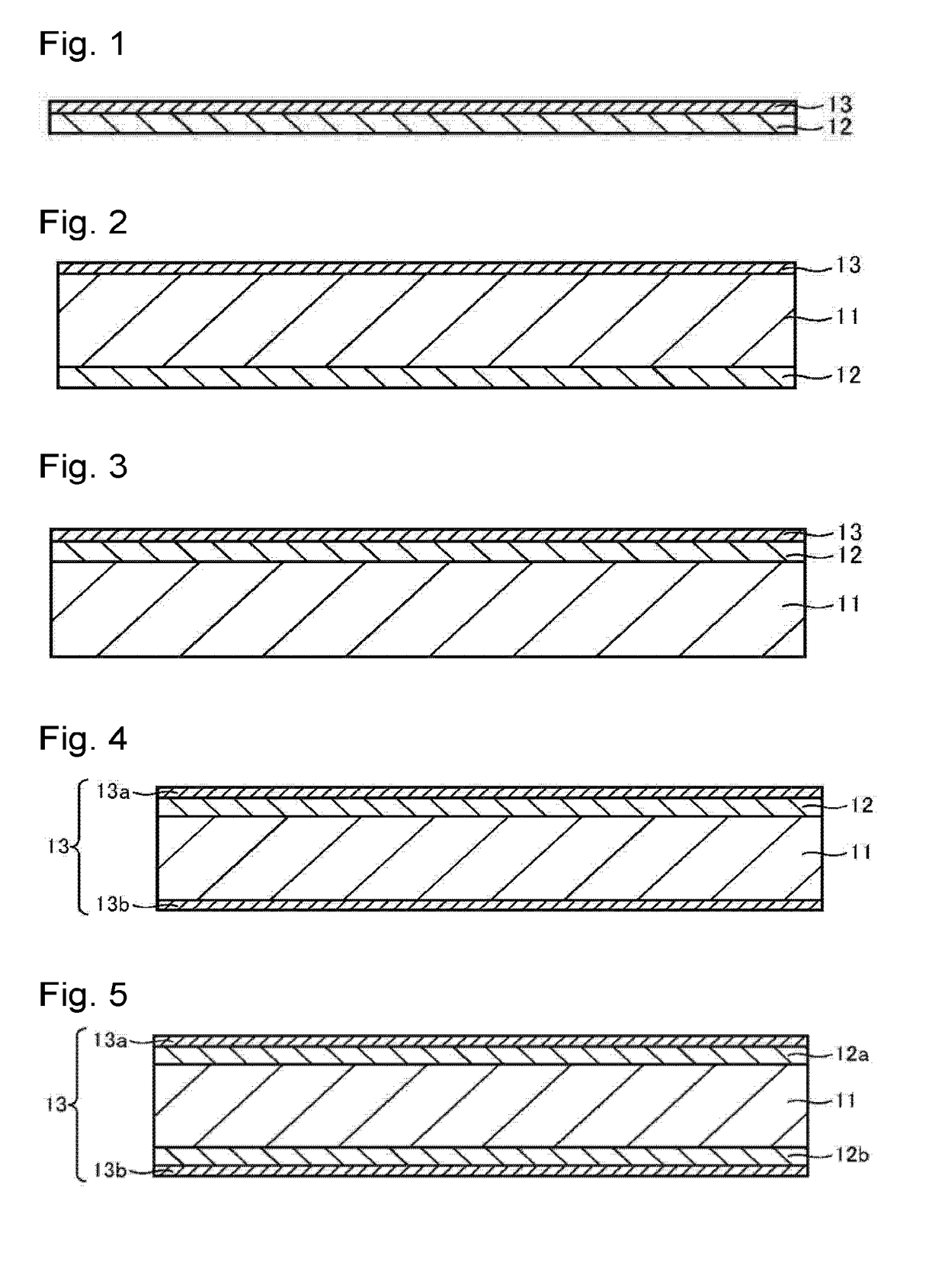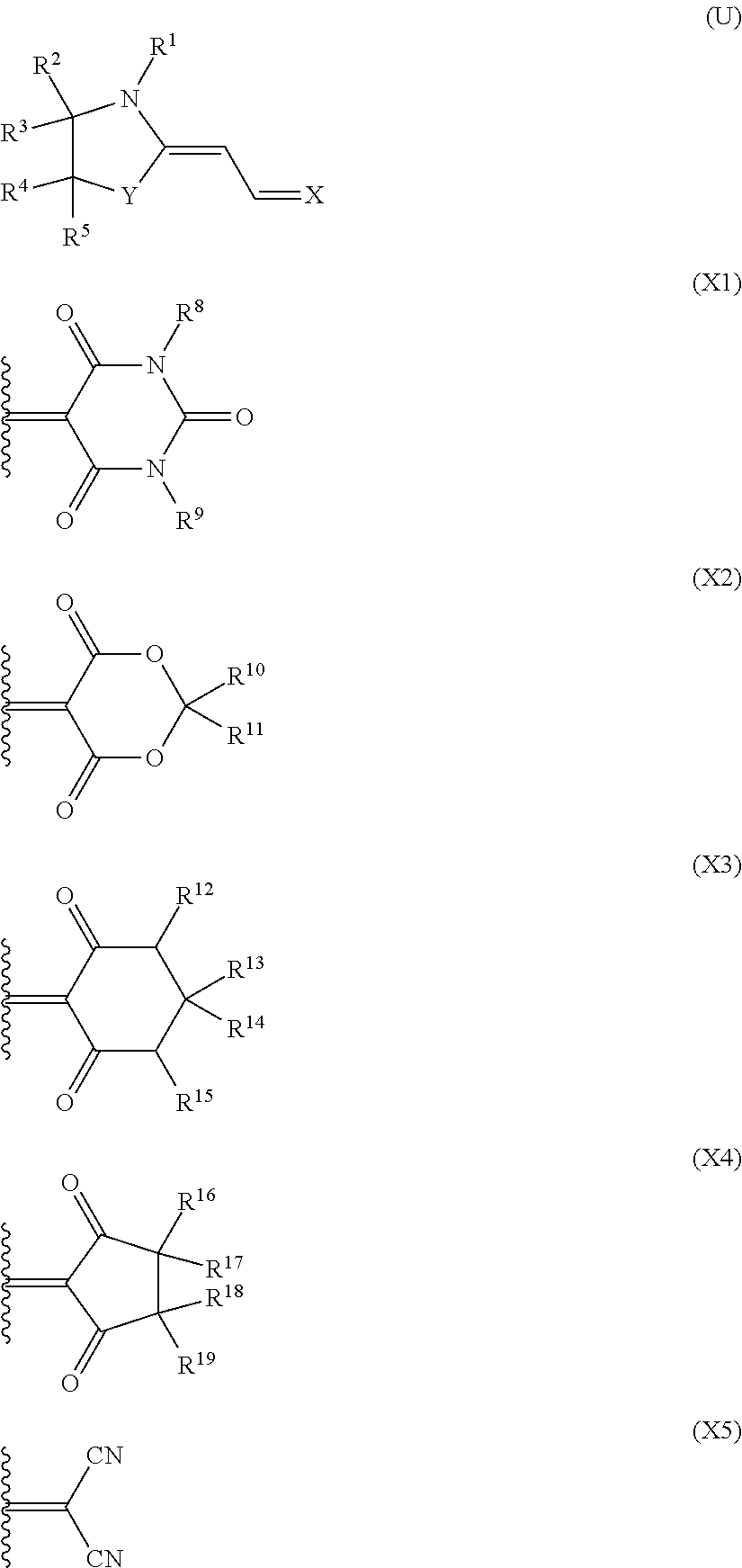Optical filter
a technology of optical filters and filters, applied in the field of optical filters, can solve the problems of insufficient ultraviolet absorbing performance of optical filters, inability to achieve a maximum absorption wavelength in an appropriate wavelength band, etc., to achieve excellent absorption properties, reduce the size of optical filters, and high shielding performance
- Summary
- Abstract
- Description
- Claims
- Application Information
AI Technical Summary
Benefits of technology
Problems solved by technology
Method used
Image
Examples
example 1
[Evaluation]
[0154]The transmittance in each Ex. was calculated by measuring the spectral transmittance curve at a wavelength of from 300 to 800 nm using an ultraviolet visible spectrophotometer (manufactured by Hitachi High-Technologies Corporation, U-3300). Dichloromethane was used as a solvent, and the maximum absorption wavelength (λmax [unit: nm]) and the molar absorptivity (unit: [L / mol·cm)]) at that wavelength are shown. In the following Ex. also, the spectral transmittance curve was measured by using U-3300 manufactured by Hitachi High-Technologies Corporation.
TABLE 2Evaluation Ex.λmaxε (molar absorptivity)No.Dye[nm][L / (mol · cm)]Eval. Ex. 1(U-2)39685,628Eval. Ex. 2(U-9)37968,968Eval. Ex. 3(U-11)39056,607Eval. Ex. 4(B-2)37728,087Eval. Ex. 5(B-1)33920,168Eval. Ex. 6(B-3)33915,555
example 2
[0155]The dye (U) illustrated in Table, the dye (A1-1) and fluorene ring-containing polyester OKP-850 were dissolved in a cyclohexanone solution, the solution was applied to a glass substrate and dried to prepare a dye-containing transparent resin body, and the transmission spectrum at a wavelength of from 300 to 800 nm was measured. The results are shown in Tables 3-1 and 3-2. Ex. 2-1 to 2-10 are Examples of the present invention, and Ex. 2-11 to 2-16 are Comparative Examples.
[0156]The dye concentration is represented by part by mass (PHR) of the dye in 100 parts by mass of the transparent resin (the same applies hereinafter). Further, in Tables, the IR absorption width is a band width within which the transmittance is at most 1% in the infrared region, the IR maximum absorption wavelength is the maximum absorption wavelength in the infrared region, and the UV maximum absorption wavelength is the maximum absorption wavelength in the ultraviolet region.
TABLE 3-1Ex. No.Ex. 2-1Ex. 2-2...
example 3
[0157]The dye (U) illustrated in Table, the dye (A1-1) and fluorene ring-containing polyester B-OKP2 were dissolved in a cyclohexanone solution, the solution was applied to a glass substrate and dried to prepare a dye-containing transparent resin body, and the transmission spectrum at a wavelength of from 300 to 800 nm was measured. The results are shown in Tables 4-1 and 4-2. Ex. 3-1 to 3-7 are Examples of the present invention, and Ex. 3-8 to 3-13 are Comparative Examples.
[0158]As shown in Tables, in Ex. 3-1 to 3-7, the difference (λ(UV70)−λ(UV15)) between the wavelength λ(UV15) at which the transmittance is 15% and the wavelength λ(UV70) at which the transmittance is 70% within a wavelength range of from 380 to 430 nm, is at most 30 nm, and the wavelength λ(UV50) at which the transmittance is 50% is within a wavelength range of from 400 to 440 nm, and sufficient shielding performance is obtained within a desired wavelength band even with a film thickness of about 1 μm. In such a ...
PUM
 Login to View More
Login to View More Abstract
Description
Claims
Application Information
 Login to View More
Login to View More - R&D
- Intellectual Property
- Life Sciences
- Materials
- Tech Scout
- Unparalleled Data Quality
- Higher Quality Content
- 60% Fewer Hallucinations
Browse by: Latest US Patents, China's latest patents, Technical Efficacy Thesaurus, Application Domain, Technology Topic, Popular Technical Reports.
© 2025 PatSnap. All rights reserved.Legal|Privacy policy|Modern Slavery Act Transparency Statement|Sitemap|About US| Contact US: help@patsnap.com



